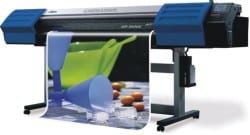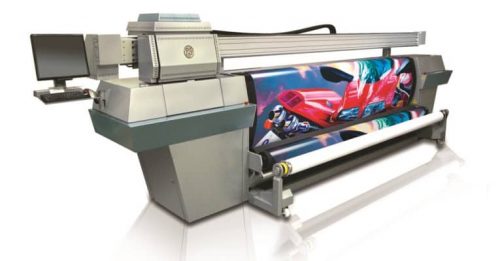Dye sublimation versus Toner-based printing. Liquid inkjet, solid Ink, and UV Printing Processes – which produces the highest print quality?
Question: What print technology produces the highest quality text and graphics? Toner-based, liquid inkjet, solid ink, dye sublimation, thermal, or UV printers?
That’s a very complex question. Off the cuff, dye sublimation would be my first answer, but that’s not very thorough of an answer because there are different substrates for different uses, and each has it’s own special ink set.
For instance, if you need a polyethylene OSHA warning sign, you are not going to be using dye sublimation printing. You’ll either screen print or use a flatbed digital printer, most likely an inkjet printer that uses liquid solvent inks. If you need a lot of signs, screen printing will probably be the most cost effective printing method, unless it is a 4 color process print.
Vinyl Printed Graphics
Vinyl decals and graphics are another item that has a few options for printing, including thermal dye sublimation printing, although it is only good for very small orders as it’s quite expensive compared to screen printing or digital inkjet printing.
Fabric Substrates
 How about fabrics like nylon or cotton? Screen-printing is generally considered the best option, although different inks are used on nylon than on cotton or other fabrics generally used for shirts and such.
How about fabrics like nylon or cotton? Screen-printing is generally considered the best option, although different inks are used on nylon than on cotton or other fabrics generally used for shirts and such.
However, for sheer printing beauty, when required, there is nothing, in my opinion, that touches dye sublimation printing on fabric banners, posters, or displays. The continuous tone printing cannot, at this time, be matched by any other method of printing.
Brief Explanation of Dye Sublimation Printing
Continuous tone printing is accomplished with the dye sublimation process. Using the CMYO (cyan magenta yellow overprint clear), the dye is printed on a transfer paper. Then once the paper is printed, it is matched up to whichever fabric the client has ordered – banner, oxford, satin, outdoor, stretch – and sent through heated rollers at about 400F.
As the fabric and transfer paper go through this heat/pressure combination, the dye printed on the paper is converted from a solid to a gas instantaneously, and is fused to the fabric in a continuous tone print, similar to a photograph.
How Dye Sublimation is Different
The difference between most printing and dye sublimation fabric printing is that most printing, including screen printing, and all types of digital printing, use a dot pattern to create color, whereas dye sublimation cloth printing has a continuous tone, just like pictures that you get developed from your camera.
So, I guess that means that my first answer is correct, at least for fabric printing. The other substrates are good for certain things, but for the classiest look in printing, you will want to definitely consider dye sub fabric printing.
One other BIG Advantage of Dye Sublimated Fabric Displays
One other plug for dye sub printed displays – if you are at a competitive trade show, or similar, and your competitors have some nice graphics on vinyl or the like, and you show up with your continuous tone printed fabric display, you are going to win the subliminal war. Face it, if your display looks rich, and theirs looks middle-class, they’ll get some clients, maybe lots, but you’ll land the best clients at better margins.
Go here to view more about Dye Sublimation Fabric Printing. You can also leave your comments down below if you have anything more to share or questions you might have.
Popular Posts:




